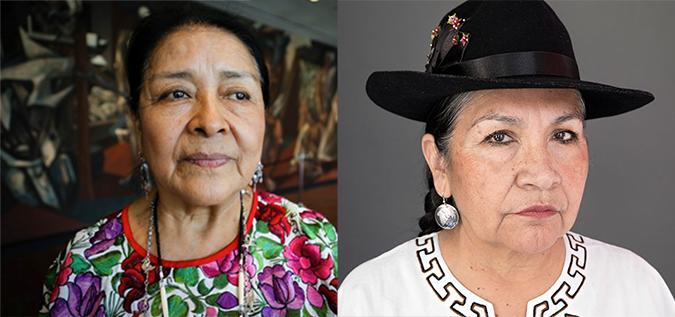Orange Day calls to stop violence against indigenous women and girls
Every 25th of the month the Orange Day is commemorated to draw attention to the elimination of violence against women and girls; in April, the theme for the Orange Day is the elimination of violence against indigenous women and girls.Date:

In April, the Orange Day is dedicated to eradicating violence against indigenous women and girls. This is a particularly complex challenge in Latin America and the Caribbean considering the many forms of violence they face: from daily discrimination to extreme forms of violence, such as the murder of the Honduran activist, feminist and indigenous leader Berta Cáceres in March 2016.
In the region, there are 522 indigenous populations who speak 420 different languages indigenous peoples represent between 3% and 10% of the population of Latin American and Caribbean countries, totaling 45 million people. Half of this population are women. (1)
The Orange Day is commemorated every 25th of the month in the framework of the UN Secretary General’s Campaign "UNiTE to End Violence against Women".
This month, Otilia Lux de Coti, , a renowned Mayan leader and activist of Guatemala and Executive Director of the International Forum of Indigenous Women Tania Pariona Tarqui, a Quechan Peruvian Congresswoman and member of the Continental Network of Indigenous Women of the Americas and Tarcila Rivera Zea, } member of the Permanent Forum on Indigenous Issues of the United Nations and founder of the non-governmental organization CHIRAPAQ, Center of Indigenous Cultures of Peru, analyze the many forms of violence suffered by indigenous women and girls in the region, and lay out the way forward to eradicate them.
"We prefer to speak of “violences”, in plural," Rivera Zea clarifies in an interview with UN Women.
"’Violences’ in plural speaks of the need and urgency to link the violence that indigenous women face with our individual and collective rights. In this plurality, discrimination and racism act as an umbrella that covers other forms of violence, which happen in the face of States and citizens that tend to invisibilize and ignore the indigenous peoples.”
These multiple forms of violence, adds the founder of CHIRAPAQ, lead to militarization of territories, human trafficking, use of pesticides and rape of indigenous women and girls. It also emphasizes the negative impact of extractive industries on communities and their interlinkage to environmental violence and the denial of sexual and reproductive health to indigenous women.
For Otilia Lux de Coti, one of the main issues is institutional violence against indigenous women and girls, since this holds back their full development and empowerment.
"Violence, discrimination and racism are scourges that prevent the full development of indigenous women and girls," says Lux de Coti, "institutional violence is particularly evident when we consider that the rule of law is not equal for all citizens".
In a context of strong institutional discrimination, the case of Sepur Zarco stands out as the first instance globally where a sentence was handed out for sexual and labor slavery perpetrated against indigenous women. A year after the sentencing, Otilia recalls the case in which two former members of the Guatemalan military were found guilty of war crimes, crimes of sexual slavery, rape, enforced disappearances, ill-treatment and discrimination against 11 indigenous women living around the Sepur Zarco detachment between 1982 and 1983.
Lux de Coti points out that key to ending this pandemic in the region is challenging social norms that reproduce gender stereotypes and racism and strengthening normative frameworks that tolerate discrimination against indigenous women and girls.
Tania Pariona Tarqui adds: “Aside from physical and psychological violence, torture, sexual violence and rape during armed conflict, indigenous women are excluded from decision making and must endure abuse of authority, including in communal assemblies, which are consultative meetings convened by the State.”
The problem is expressed in practices of physical elimination of indigenous populations, appropriation of their territories, displacement, destruction of their cultures, and in the case of indigenous women, invasion of their bodies. Sexual violence against indigenous women has long been a practice by various actors, including State actors.. Indigenous women, particularly those living in rural areas, in contexts of inequality, exclusion and extreme poverty, are also affected by internal armed conflicts, in which many have not only lost their belongings, but also their families and their physical integrity. (1)
"The matter is serious not only because of the figures but also because of the impunity and indifference, although society has begun to express its rejection with much more strength in recent years," adds Rivera Zea.
"The forced prostitution of wayuu girls in Venezuela, female mutilation in Colombia, cases of femicide, the high rates of early pregnancies in Peru and other countries in the region, as well as the assassination and persecution of indigenous women defenders of collective rights demand concrete actions and decisions ".
Addressing the issue is not about going against indigenous cultures, according to the Peruvian activist, but challenging cultural practices that reproduce this violence against indigenous women and girls.
"Many experiences that are a source of resistance against violence, based on our own indigenous references, focus on the valorization and revaluation of traditional knowledge, identity strengthening and prioritization of being and collective well-being”.
"We must not go against our cultures, but against cultural practices that hurt us and violate our human rights as indigenous women."
(1) Violence and Indigenous Women, document prepared by CHIRAPAC for CSW16.
Other relevant publications:
Violence and Indigenous Women. Document prepared for CSW57
Violence and indigenous Women